Leica Summilux-SL 50mm f1.4 ASPH Lens Review:
Before the Summilux-SL 50mm f1.4 ASPH was released, there were just the two zooms for the Leica SL system. The zooms are superb but if you wanted a prime, your main option was basically to buy an M adapter, so you could use M lenses. I was an M user at the time but I was at a point where I was seriously considering moving on to another system. I love Leica products, I was a diehard M user, and I’ve used them for decades. My path into photography actually started with an M3 and a 50mm Summicron, so my love for Leica runs deep. But my photography has changed quite a bit; I shoot mostly fashion, portrait, and boudoir now. Also, focusing fast lenses, especially telephotos with an M just became more difficult for me.
Still, I love the Leica rendering, and I love their products. I didn’t want to switch to another brand. The SL was really appealing to me because not only was the system autofocus with the ability to also use my M lenses, Leica promised this would be a professional camera system with lenses that would set new standards. The lenses in this system are supposed to be about Leica pushing their limits of what is possible with their lenses. I found the M lenses already some of the best in the world; it was hard to imagine better.
The thing is…I was an M user for decades. It was difficult to imagine using another type of Leica as my main camera, a camera without a rangefinder, and if I was going to make a switch, I wanted to make sure I had lenses that would come out, at least in the near future, that I was going to use. Well, I heard rumors about a new 50mm Summilux, which quickly became fact. The 50mm Summilux-M is my favorite M lens but in the case of the SL system, this version was suppose to set the new standard for what is currently possible from Leica. This was suppose to be a new reference. PLUS, it would be autofocus :).
So, after hearing news about this, and also taking out the SL for a lengthy test drive, I switched systems in November of 2016. I wasn’t expecting the Lux till around February of 2017, but thanks to the Leica Boutique at Bergen County Camera, I might’ve even been the first one or at least one of the first in the states lucky enough to receive a production version of the Lux. I ended up getting my copy the first week of December 2016.
So, I’ve been shooting with the Summilux-SL 50mm ASPH ever since. In fact, this is my most used lens by far in any system right now. Check my Instagram account, and you’ll see that nearly all the pics in the past year were shot with this lens. I have anywhere from one to three shoots per week, and there are many times where I rake in a couple of thousand images per week. So, while this review is about 3 years late, it’s also based on what I’ve experienced with it, and what I’ve shot for my own work over that amount of time, so maybe it’ll give you a more in depth look at the Summilux-SL 50mm ASPH through a user’s perspective. So, I hope that this review helps you, and you enjoy it. This isn’t quite as long as my Summicron-SL 90mm review but I think it has more pics ;). Let’s start.
Leica Summilux-SL 50mm f1.4 ASPH Lens Build Quality:
Leica lenses have always been at the top in terms of build quality, and the Summilux-SL 50mm f1.4 ASPH is clearly no exception. Yes, Leica lenses are very expensive but in addition to great optics, you’re also getting your money’s worth in terms of overall build quality. The build, the quality, materials used, and just the sheer solidness of their products is on another level, and it’s something you don’t see often anymore, and I’m not just talking about camera gear.
Nowadays, many things are built just good enough, whereas these lenses are over-built. They’re designed to last a very long time. For instance, I’m still using all my dad’s M lenses from the 1980s, and what’s great is they still work on current cameras like digital Ms or my SL. Some people are using even older lenses than I am with no issues at all. So, if you ask me, you are really getting your money’s worth when you purchase a Leica lens, and keep in mind that after a while, many demand a high resale value.
So, you can bet the SL lenses, in this case, the Summilux-SL 50mm f1.4 ASPH, are going to be built to extremely high standards, especially since Leica markets the SL as their professional system. The major difference to me between this lens and say an M lens is that while an M lens may be thought of as a fine jewel or watch, the 50mm Lux just feels like an anvil :). I’m going to get this out of the way right now: at $5,295, the Summilux-SL 50mm ASPH is not cheap. But after holding this lens, and just getting the overall feel of it, I can tell you that no expense was spared in making it. The Summilux-SL 50mm ASPH is built like a tank. It’s all glass and solid metal, with extremely tight tolerances. This type of build quality is really something you don’t see often anymore. It’s just so dense and solid.
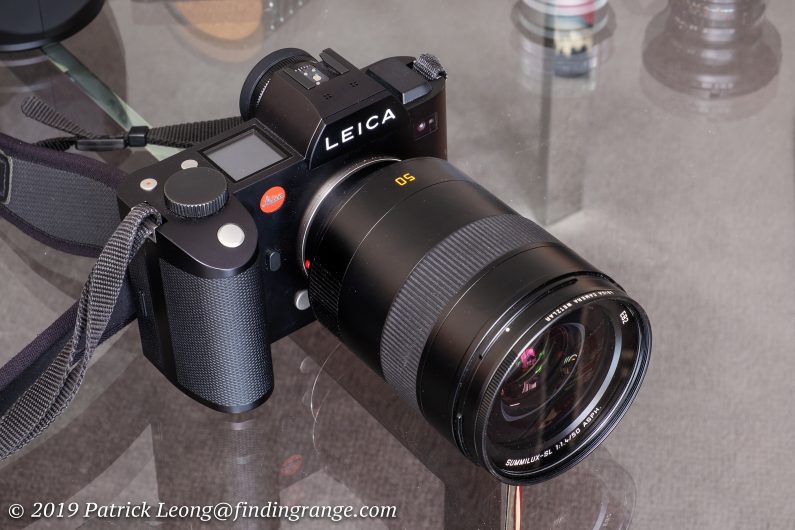
↑ The Leica SL with the Summilux-SL 50mm f1.4 ASPH.
Now the build is superb but here’s the thing: Let’s just say that this isn’t the most compact and light lens out there. I joke that this is like an anvil but seriously speaking, it sometimes feels like one. The Summilux-SL 50mm f1.4 ASPH is an all metal design that weighs 1.065 g. The length of it is 124mm, which is only 14mm shorter than the Vario-Elmarit-SL 24-90mm ASPH. It even uses an 82mm filter thread just like the zoom. But you have to remember something: the Summilux-SL 50mm was designed to deliver maximum performance, and as Leica says, “set new benchmark standards in terms of sharpness”. In other words, this is a no-compromise lens that’s all about image quality, and honestly, that’s exactly what I wanted. I knew what I was getting into when I first ordered this lens. I love 50mm lenses, and I wanted the best 50mm Leica could make, and if it meant carrying around a larger lens, I was willing to make the sacrifice.
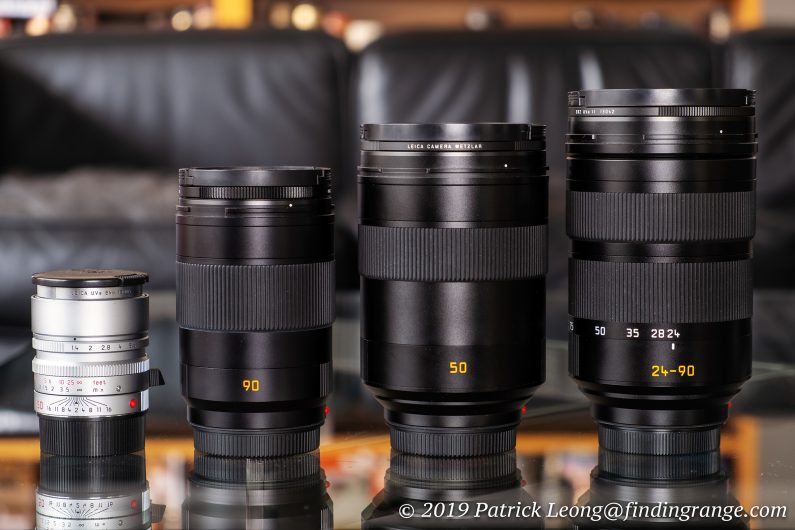
↑ This picture is to give you an idea of the size of the Summilux-SL 50mm. In the picture from left to right is the Summilux-M 50mm ASPH, the APO-Summicron-SL 90mm ASPH, the Summilux-SL 50mm, and the Vario-Elmarit-SL 24-90mm ASPH.
Of course, I’m not saying this is for everyone. You have to get what you love and will use, especially at this price. In fact, Leica just recently released the cheaper, and much smaller APO-Summicron-SL 50mm f2 ASPH for those who just want a more compact 50mm to carry around that will also deliver incredible image quality. But if you’re after a lens that pushes the current optical boundaries and is considered a new reference all while also having a large aperture, designers and engineers need to have the flexibility to disregard things like size limitations. It’s not easy to put all of that together, and let’s be honest, it’s not the only fast reference lens out there that is large. Keep in mind that the Summilux-SL 50mm ASPH is also dust and weather-sealed, and has internal focusing, so the overall lens length does not change. Lastly, it’s also autofocus.
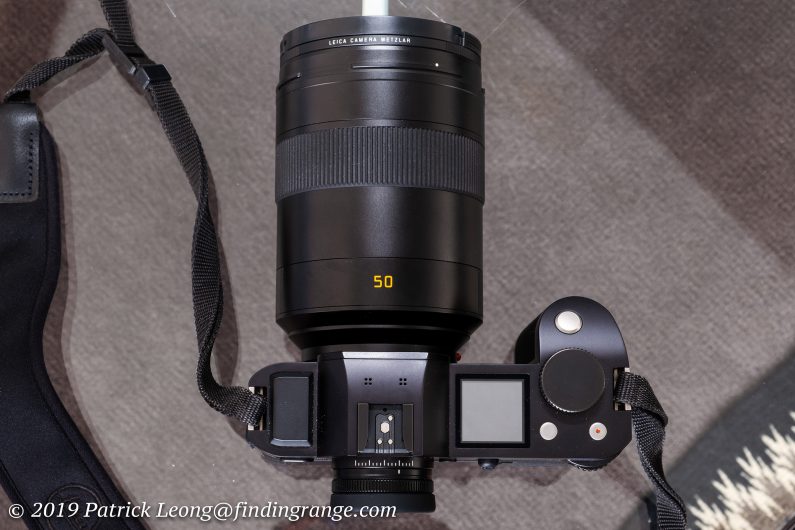
↑Here’s a top view of the Summilux-SL 50mm ASPH while mounted on the SL.
With all that said, I have no problems using this lens as my daily user. You can ask any of the models I’ve worked with or take a look at my Instagram page. I currently own 3 SL lenses but if you look at the picture on my Instagram, they are mostly shot with the Summilux-SL 50mm f1.4 ASPH. This is my go-to lens. It’s my daily user. I don’t just shoot in a studio setting, I also do a lot of street fashion, so I’m walking around with this lens quite a bit. Yes, it’s not light, and at first, it felt like a big change from my M 240, and Summilux-M 50mm ASPH but you get used it. Plus, I actually find the weight a bit refreshing, since I feel more stable when I shoot. Again, different strokes for different folks but don’t let anyone tell you a lens like this can’t be used all the time because that’s not true. I use it all the time. As I mentioned before, I do anywhere from one to three shoots per week. Sometimes I’ll rake in a couple of thousand images with this lens per week.
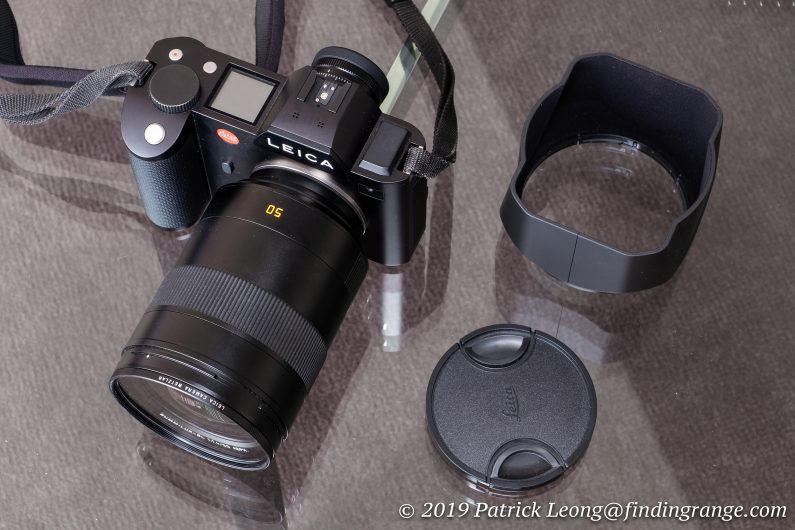
↑ The Summilux-SL 50mm ASPH comes with a lens hood. The inside of the lens hood is felt covered.
It’s also worth mentioning that while the Summilux-SL 50mm ASPH is a large lens, it’s quite balanced on the SL. It feels really nice. On a side note, the SL was really designed well in my opinion. From my experience, it feels great with a variety of lenses from smaller ones like the Summaron-M 28mm (which I reviewed here) to larger lenses like this Summilux-SL 50mm ASPH. Together with the Lux, the whole combo just feels so solid and professional.
Leica Summilux-SL 50mm f1.4 ASPH Lens Autofocus:
Now, if there was an Achilles’ Heel to the Summilux-SL 50mm ASPH, it would probably be the autofocus. When I first got it, it was a bit sluggish. But it did receive a firmware update that sped up the autofocus considerably. It’s still not blazingly fast, and definitely not as fast as the Vario-Elmarit-SL 24-90mm or the APO-Summicron-SL 90mm ASPH but with that said, it’s pretty quick now. You have to remember though that the Summilux-SL 50mm ASPH is all about getting the absolute best image quality, and achieving this with a large aperture is not easy. It’s a big lens with a lot of heavy glass; I’d imagine it’d be pretty difficult to make it faster without further increasing the size to maybe accommodate a larger motor, for example. Plus, think about it this way: it’s definitely faster than manual focus, and you’ll probably get more keepers ;).
I get direct messaged on Instagram and emailed all the time asking me how the autofocus is when it comes to portraits. Look at my work in this review and on my Instagram; the lens focuses quite well in a variety of shots and conditions. The autofocus is also smooth and silent. It performs quite well during my shoots. It has even taken sharp photos at f1.4 while a model was walking towards me. Sure, I’d love the autofocus to be as quick as my APO-Summicron-SL 90mm f2 ASPH but I’m still getting the images I want with it all the time. I’m also shooting with different people all the time, and the reason I’m mentioning this is because people move differently. Some will stay posed until they hear the click but some will change poses really quickly, and guess what? The Summilux-SL 50mm ASPH keeps up. It doesn’t ruin the flow of my shoots, so to me, I don’t think this is a major issue, especially after the last firmware update.

↑ Here is Tiffany walking towards me while I shot her at f1.4.
It’s also great to just have a reference level 50mm f1.4 lens that Leica themselves says breaks new boundaries in lens design that has autofocus. You have a better chance of achieving the lens’ optimum quality. Manually focusing a 50mm at f1.4 quickly is not an easy task. Imagine having to tell the model you have to slow it down a bit to make sure focus is accurate or finding out the eyes weren’t sharp after you took the images. This lens focuses even at f1.4 very easily, and very accurately as well. That’s one thing I love about this lens, and one area where I was a bit annoyed at times with my Summilux-M. Yes, the Summilux-M performs superbly at f1.4 but guess what? I’m not nailing the focus all the time, so I’m not always getting the best that that lens has to offer at f1.4. I don’t want to go back to the model, and say I want to reshoot a certain set because I didn’t get the focus down, and I don’t want to convince myself that focus isn’t everything. We all feel different about things but this is how I feel: if I didn’t want a razor sharp image, why did I pay so much money to buy a lens like this in the first place? With the Summilux-SL 50mm ASPH, I’m nailing the the shots, so I’m getting the best that this lens has to offer even at f1.4.
Leica Summilux-SL 50mm f1.4 ASPH Lens Image Quality:
As for image quality, what Leica has been saying about the SL lenses, and how they are designed to push the boundaries of lens design is definitely not an overstatement. All the SL lenses I’ve used are incredible, and this includes the Summilux-SL 50mm f1.4 ASPH. Yes, this lens is expensive, and yes, it’s large; but just WOW…seriously wow. The 50mm focal length is my favorite, and I’ve used quite a lot of them including Leica versions. This is without a doubt the best 50mm I’ve ever had the pleasure of using. The image quality that it produces is just on another level, and it plain out sucks that I can’t post full resolution photos here. Leica set out to make a 50mm that redefines reference, and is best in class; this is it.
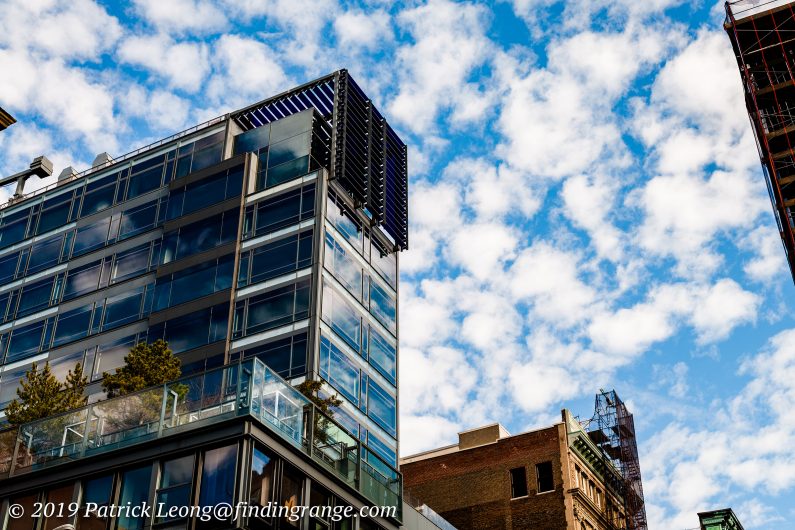
↑ I wish I could post the full resolution pic of this photo. It’s insanely sharp. This was taken at f8.

↑This was taken at f1.4. Black and white conversion done in Camera Raw in Photoshop CC.

↑This was taken at f1.4.

↑ This was taken at f1.4.
Let’s start off talking about sharpness. The Summilux-SL 50mm f1.4 ASPH is incredibly sharp. In fact, as I said in my APO 90mm review, this lens also redefines it. I’ve used plenty of lenses, especially for this site, and without a doubt, this along with the 90mm are the sharpest lenses I’ve ever used. You can see even the smallest and most minute details in an image. Even after almost three years, I still can’t get over how unbelievably sharp the Summilux-SL 50mm ASPH is.
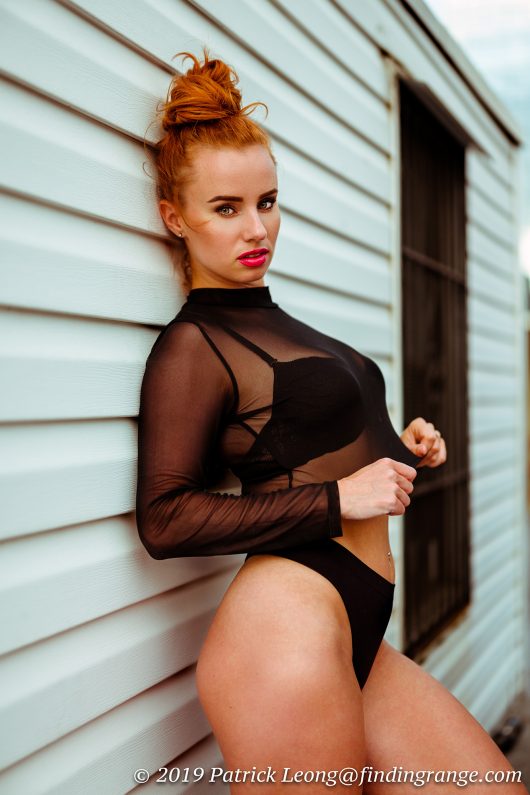
↑ Here’s another shot at f1.4, this time on a rooftop.

↑ Here’s another taken at f1.4.

↑ I shot this before the firmware update, so the autofocus wasn’t as fast as it is now. Still, it locked on here at f1.4, and there were a lot of things moving around here.
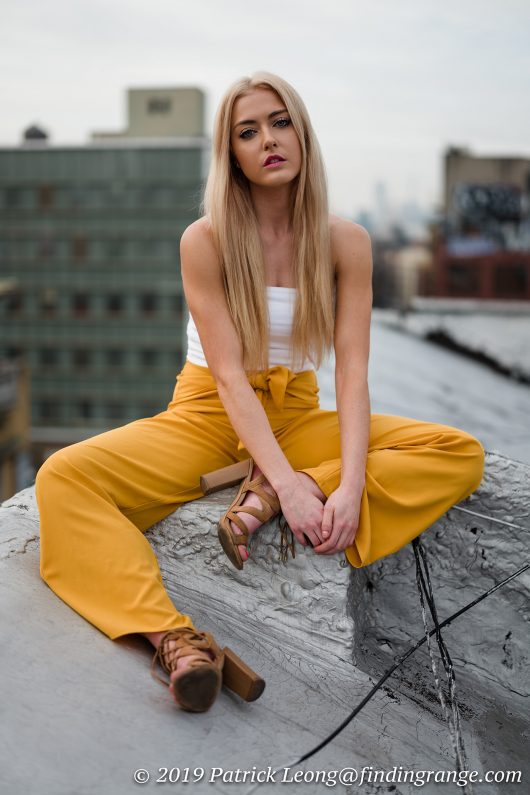
↑ I’ve shot with Michelle so many times, I’ve lost count :). This was taken at f1.4 on a rooftop.
The great thing is you don’t have to stop down or anything like that to get the most out of the Summilux-SL 50mm ASPH. You’re getting edge to edge razor sharpness even at f1.4. You’re not adjusting aperture here to get better sharpness; you’re only doing it to control depth of field and lighting. In other words, I can’t even see the difference in sharpness with my eyes between f1.4 and say f8, for example.
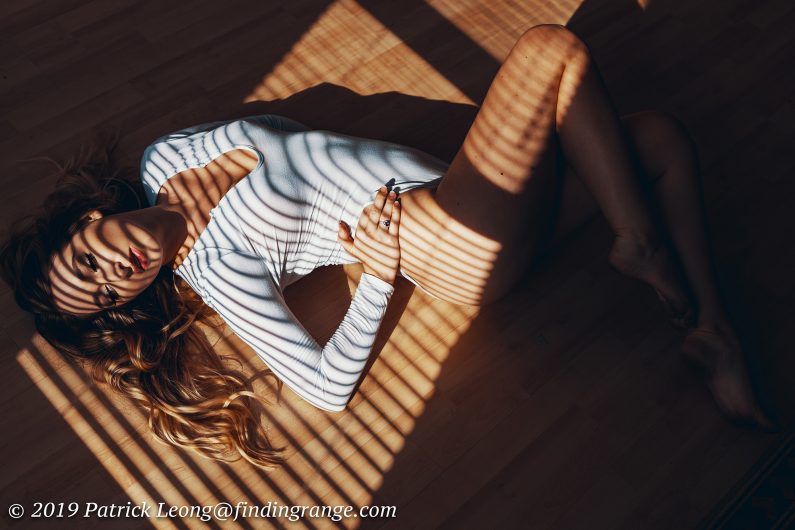
↑ This is a pic was taken at f4. If you want to see the rest of this set, I do a weekly portrait set on my site, and hers is here.
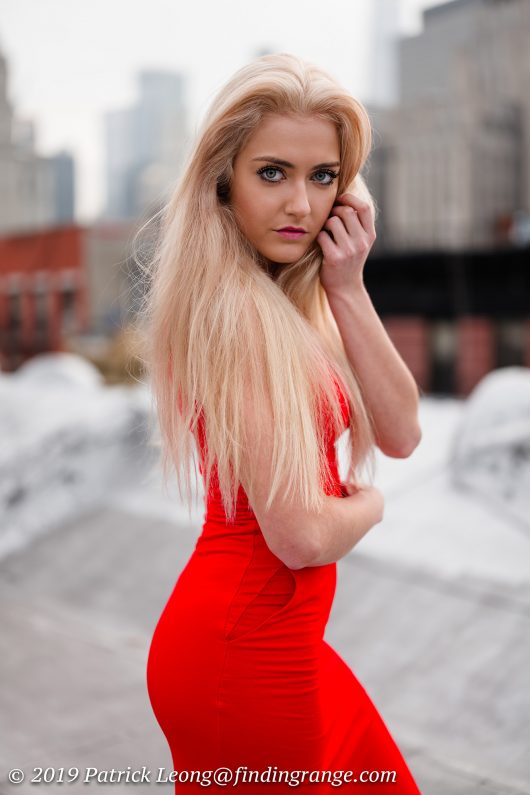
↑ Here’s another at f1.4.
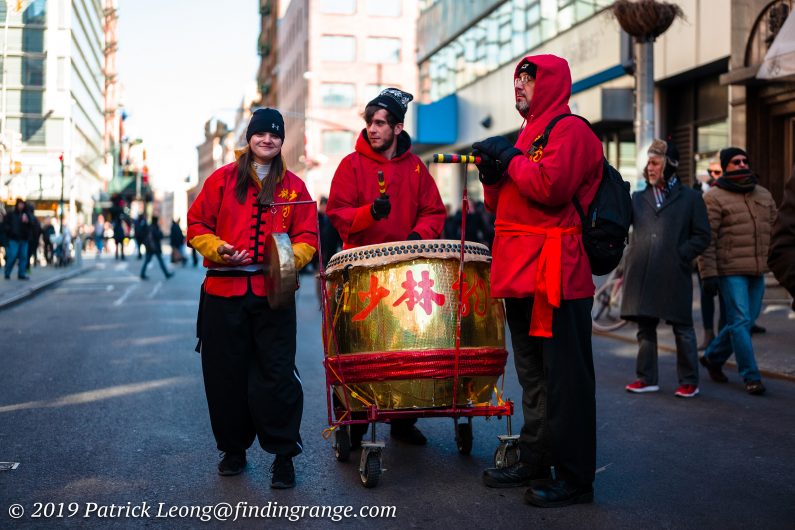
↑ This was taken at f1.4 before the firmware update, which sped up the autofocus.

↑ Here’s another shot at f1.4.
Speaking of f1.4, imagine having an image so sharp that you can see the tiny hairs out of pores in facial skin? It may sound kind of gross haha but that’s what we’re talking about there. I see dust on eyelashes; I see specs of dust floating around subjects in images sometimes. The sharpness at f1.4 is simply astonishing. it’s on another level…it’s extraordinary. I’ve never said this before but it’s perfection. This is one major area that sets this lens apart. I’ve not shot with any other f1.4 lens like the Summilux-SL 50mm f1.4 ASPH.

↑ This was taken at f1.4 with black and white conversion done in Camera Raw Photoshop CC.
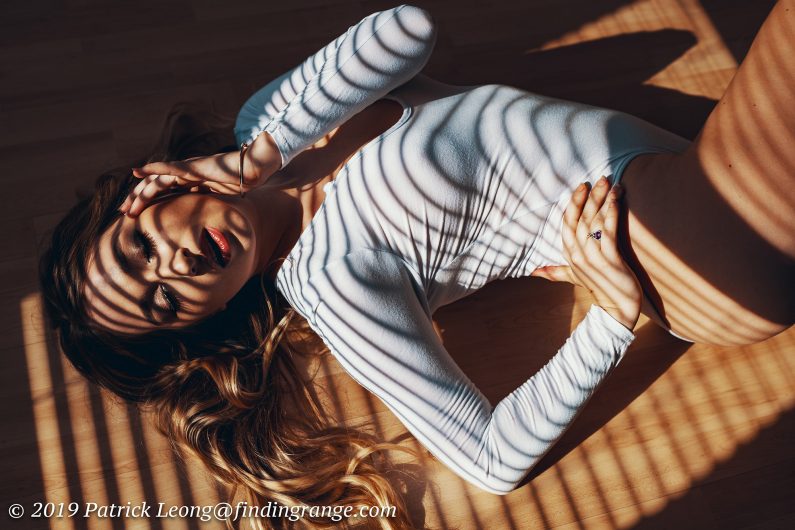
↑ This was taken at f4.
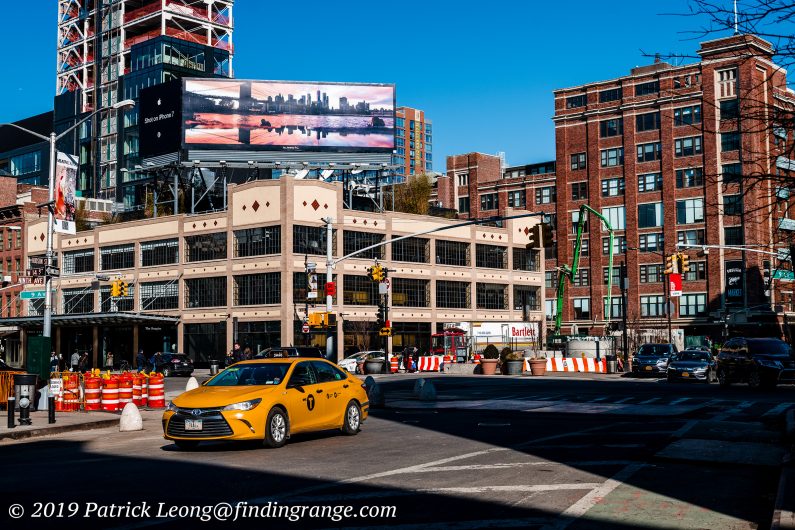
↑ This was taken at f8 in Chelsea.

↑ This was taken at f1.4 with black and white conversion done in Photoshop CC Camera Raw.
As for other attributes, things like contrast and color rendering are perfect. In terms of flare, I’ve been using this lens in shoots almost every week for a few years now in all types of conditions from studio, bright, sunny days to cloudy, moody days. I’ve shot in rain, snow, and hot summer days with not a cloud in the sky for protection; bottom line is I can’t even remember an image where I’ve seen any flare in my photos. The Summilux-SL 50mm ASPH has a multi-layer coating designed to prevent flare and ghosting, and it works. I also don’t use the the supplied lens hood because it makes the lens look considerably larger but it’s just not needed. For protection against bumps, I just use a UV filter.

↑ This day was very sunny with harsh lighting. I used the sun to backlight, so it was basically in front of me. Still, the Summilux-SL was highly flare resistant. This was taken at f1.4.

↑ This was one of the first pictures I took with the Summilux-SL 50mm ASPH. This was processed in Capture One, and grain was added. This was taken at f1.4.

↑ This was taken at f1.4.
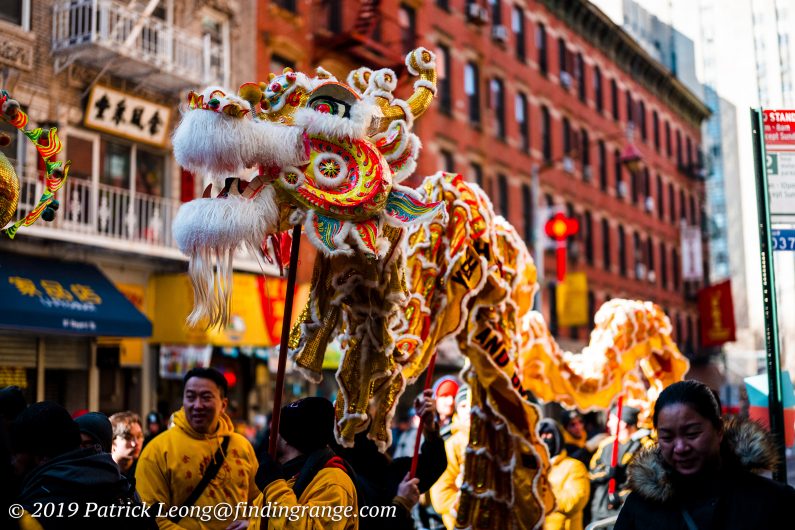
↑ Here’s another taken at f1.4.
Besides all the technical stuff, the Summilux-SL 50mm f1.4 ASPH overall just produces photos with such a great look to them. It has character, which to me, is what truly makes a lens great. There’s just so much detail that this lens retrieves but at the same time, the photos still look real and organic. There’s nice depth in the photos and liveliness. There’s plenty of “pop”, and you don’t have to always shoot wide open with the lens to isolate your subject to see that “pop”.

↑ Donuts, Fruity Pebbles, and ice cream :). This was taken at f1.4.

↑ This was one of my the first photos I took with the Lux. This was processed in Capture One. This was taken at f1.4.

↑ Here’s another taken at f1.4.
Most of my examples here are portraits and fashion. It’s what I mostly do now, and as some of you know, I review all gear by actually using them in my own work. I probably would’ve added more variety but since this lens is three years old now, I’m assuming there are plenty of reviews that most of you have read that have more variety in terms of pics. The portraits here are edited to my taste, and these pictures were taken throughout the years that I’ve owned the Summilux-SL 50mm ASPH, so of course, my editing has changed over that time. The pictures reflect that. Since this lens captures every little detail, most blemishes have been removed. Also, in some cases, there was softening of parts of the skin but the photos are still incredibly detailed. I don’t usually post unedited photos of models I shoot because no one wants an uncorrected photo of themselves on the internet. Out of respect for them, I just would never do that. I did include street and city pics that have very little editing though.
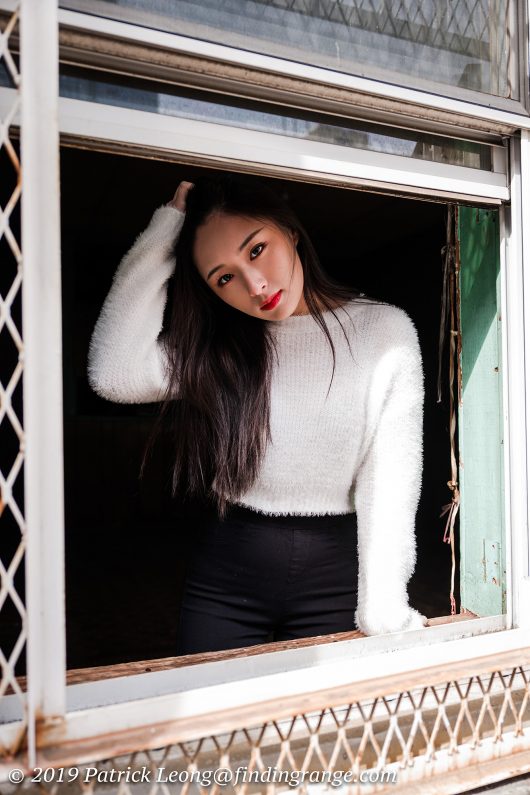
↑ I had this “thing” for window shots at one point :). This was taken at f1.4.

↑ This was another harsh day. The lighting was definitely not ideal but you work with what you have. This was taken at f1.4.

↑ This was also taken at f1.4.
Leica Summilux-SL 50mm f1.4 ASPH Lens Depth of Field And Bokeh:
In terms of bokeh, it should be a given that the Summilux-SL 50mm f1.4 ASPH is going to be quite good. Quite good maybe be an understatement; this lens actually produces some of the most buttery smooth bokeh out there. It’s everything you would expect from a lens Leica calls its reference. Everything melts away beautifully. Nothing is harsh even when you’re dealing with backgrounds that may not necessarily always be ideal for bokeh shots, such as, trees or a lot of lines. The bokeh is definitely a more modern look but the contrast between how sharp your subject is and the buttery smooth background really just makes a picture pop right out of the page.
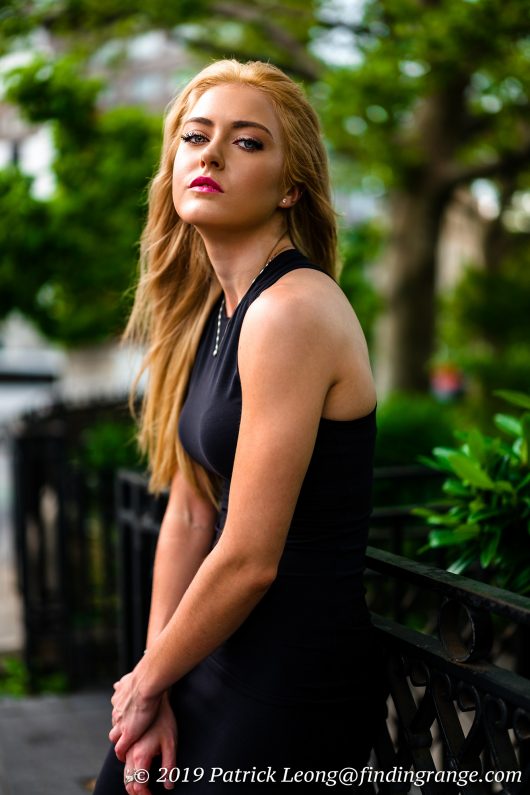
↑ The bokeh is ultra smooth and inviting with a more modern look.

↑ Here’s another example of the bokeh. As you can see, even buildings smooth away nicely.
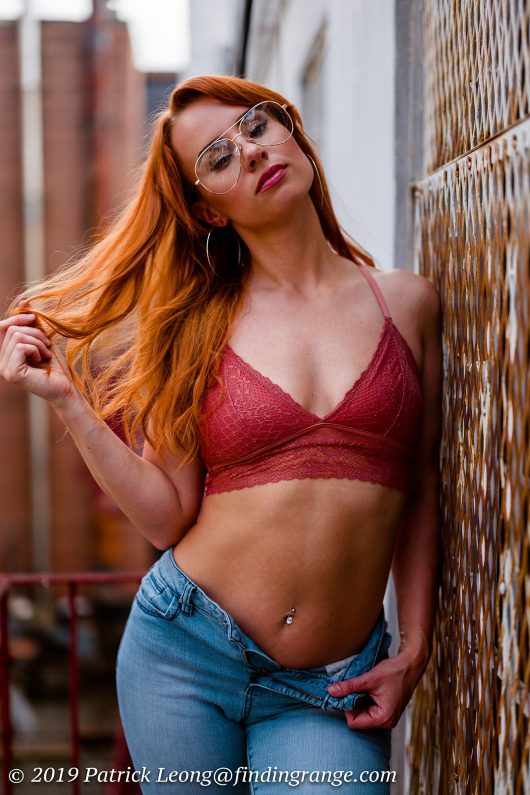
↑ Another bokeh example.

↑ Even city streets get blended away nicely.
I’ve been shooting the Summilux-SL 50mm f1.4 ASPH for a few years already, so I’ve shot in many different areas and situations, especially at f1.4; there wasn’t one time where it produced results that I did not like. If you look around my site, I’m not a photographer that shoots everything at maximum aperture. However, I shoot wide open quite a bit now with the Lux and APO-Summicron-SL 90mm because I just love the looks that these lenses deliver. Most of my examples here were taken at f1.4. The bokeh is just so nice and smooth, and i just love how sharp the subject is in the pics. I love the way the sharpness of the subject transitions to the smoothness of the background. Leica lenses have always been great at this, and it just looks like they further improved that here.

↑ This is how the bokeh looks like indoors.

↑ Here’s another example showing the bokeh with city streets in the background.
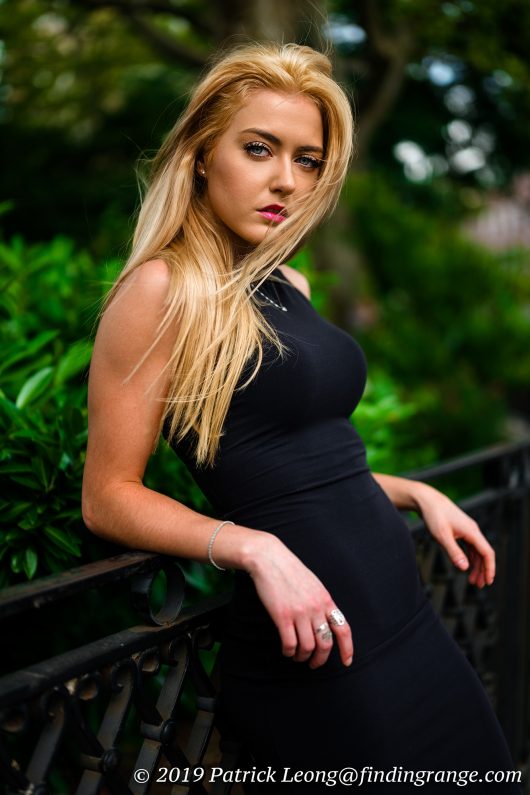
↑ This is an example with trees and bushes in the background.

↑ Here’s one more example.
Leica Summilux-SL 50mm f1.4 ASPH Lens Verdict:
The whole point of the SL system was for Leica to produce a professional level camera system that push the boundaries of what they were able to achieve. This is clearly evident with every lens that Leica has released so far for the SL system, and of course, the Summilux-SL 50mm f1.4 ASPH is no exception. In fact, this lens has far exceeded every single one of my expectations.
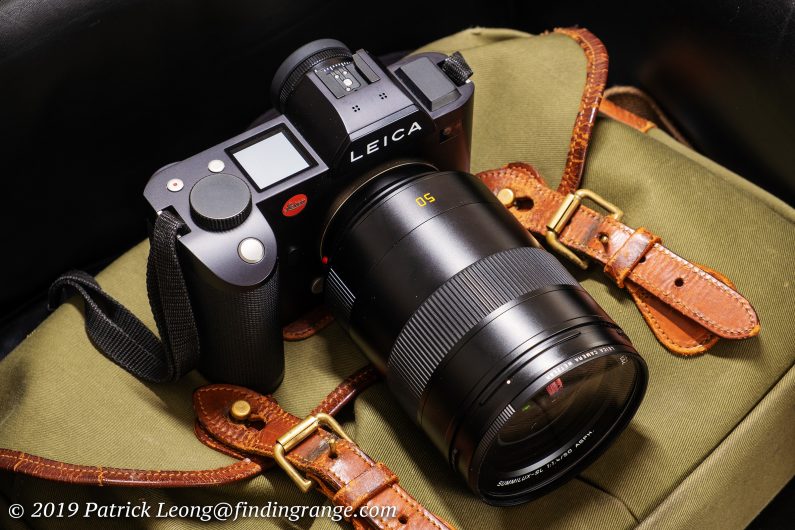
↑ One more pic of this beast mounted on the SL :).
Now, some of you may think I’m just another guy in love with Leica gear, and you know what? That may be true in most cases :). I won’t lie; I’m a huge Leica fan but with that said, I use my gear for my own work, so I’m not just going to buy something because of the name. It really needs to perform well. With the price I paid for this lens, I could’ve bought pretty much anything else with even some money left over as well. But I didn’t because I genuinely love this lens and what it produces.
As I mentioned, I’ve been using the Summilux-SL 50mm ASPH since it was first released. I bought mine the first week in December 2016. I use mine every week, and I shoot anywhere from hundreds to thousands of images per week with it for my own work. It is my most used lens out of any system I own. So, I’m not someone who is talking about this lens but is only getting info from press releases or only played with it for a “short period” of time at a store. In fact, there isn’t even much technical data in my review. I didn’t get this lens for a couple of weeks just to review it. I didn’t get this lens directly from Leica, so no favorites are being played here. This is my own copy , so all my conclusions about the optical performance and usability are coming from actual extensive use in the field. I use it for my own work, so I actually depend on it.
Now with that said, is the lens perfect? Not quite. I’ll be the first one to admit it’s a beast. When I first handled the Summilux-SL 50mm f1.4 ASPH, it was a little intimidating. But it’s not the only reference level f1.4 lens out there that is large; it kind of comes with the territory. It is definitely not for everyone, and it does not have the quickest autofocus around.
But you have to remember that when Leica designed this lens, they had only one goal in mind: take a no-compromise approach to designing a 50mm lens that would be considered a new reference. Size and weight were not taken into consideration; the philosophy here is let’s just make something that will produce downright killer images, and something that will set new standards, push the limits of optical performance to new heights, and also be able to do this at f1.4. As I said earlier by the way, f1.4 is perfection. Nothing else like it. There are plenty of smaller 50mm lenses out there, if someone is looking for one, especially with the L-mount Alliance. Leica wanted to make a statement with the Summilux-SL 50mm f1.4 ASPH, especially since it was going to be the first prime for the SL system. Did they succeed? You bet they did. Like the APO 90mm, this is a masterpiece of a lens, and something that is just truly special.
Thanks for taking the time to read my review! If you’re considering purchasing the Summilux-SL 50mm, and my review helped you decide, please help support this site by purchasing from any of the links in this review. It will not cost you anything extra. Thank you for your support!
Summilux-SL 50mm f1.4 ASPH at B&H Photo
You can also give Bob a call at the Leica Boutique Bergen County Camera. They have been a Leica dealer for decades, and they can pretty much get anything!

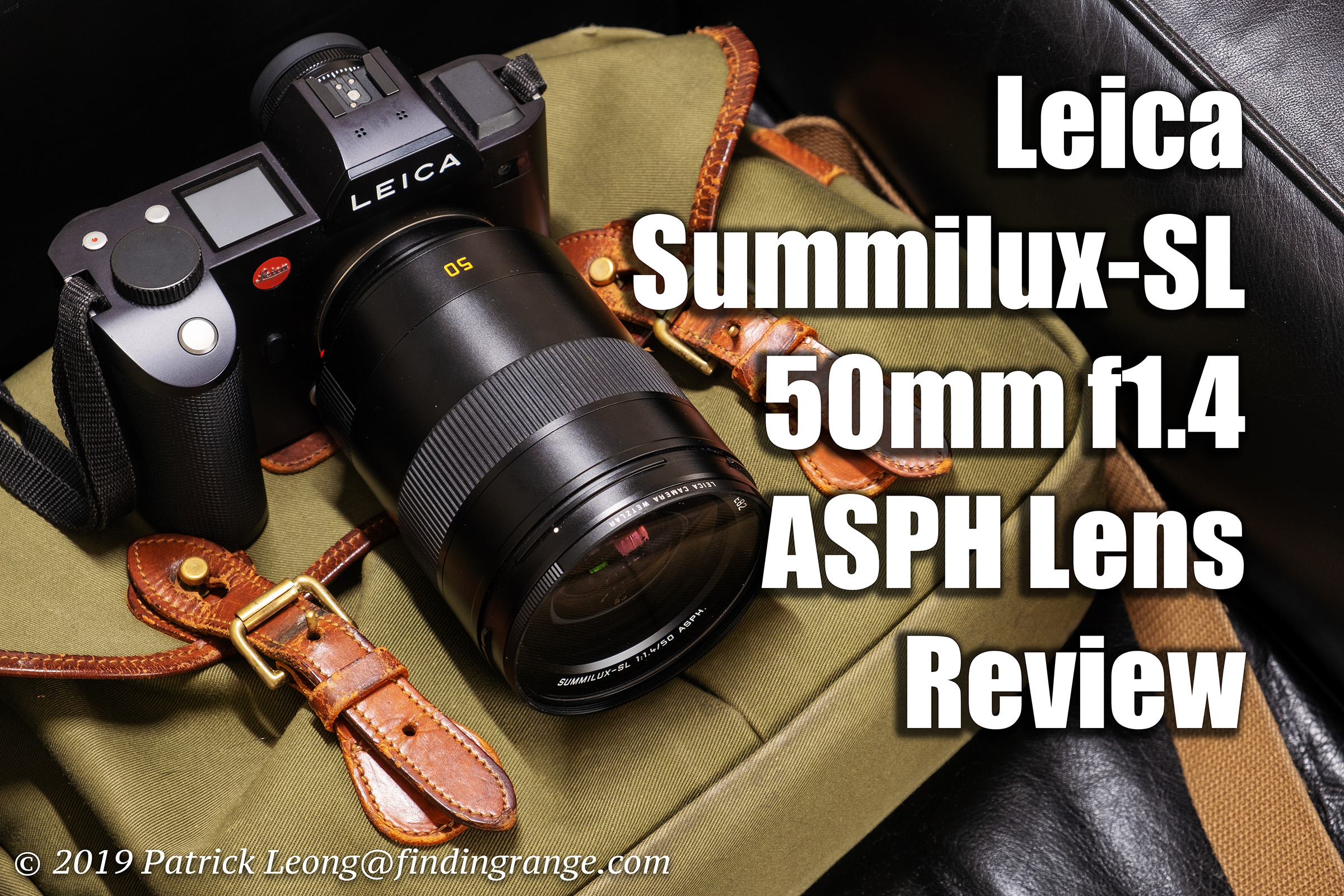
Hi Patrick
Thanks for this enthusiastic and genuinely impassioned review of three years using the beast of SL primes. It is so unloved! This is because of sheer girth and supposedly AF too slow. Used prices are the lowest in the U.K. for any SL lens and that begins to increase the attraction – most are hardly used.
Panasonic and Sigma fast L 50s are also v large if cheaper so it may be the SL 1.4 is unfairly maligned on that count.
I wonder, is there an update on its rendering/ Af performance on SL2 ?
So pleased you posted complex and challenging bokeh shots. Mixed deciduous backgrounds with sunlight thrown in is the acid test for bokeh quality in my view and at low res these look smooth. I find my modern 35mm M summicron does very badly in such situations.
Do you think that the pop and separation of subjects is as 3D as the smaller SL primes like your 90? Much is made of this in the marketing literature for the 35 and 50 SL summicrons.
Did the lens stay in the kitbag or has it yielded to a 50 SL f2 given the fantastic AF, loss of 400g and extraordinary MTF performance ?
Thanks
Darrel
Hi Darrel,
Thanks for taking the time out to read my review! I’m only guessing here, and I’m definitely not speaking for everyone but from what I gathered from emails and direct messages I’ve received from people interested in this lens is it may be unfairly judged because often times, SL gear was compared to M gear by Leica users, at least in the beginning. As Leica users, we’re used to more compact gear like M lenses, for instance. Every SL lens initially released was large and heavy. But it comes with the territory when you want an f1.4 reference level lens that supposedly redefines its category all while also having autofocus, and being built up to Leica standards. That’s not an easy task to do, and as you mentioned yourself, Panasonic and Sigma (along with many others) have done the same with their reference level lenses. In fact, the Sigma 40mm f1.4 I reviewed a couple of months ago, is larger and heavier.
As for pop and separation, let’s put it this way. I’ve owned the 90mm almost as long as the 50mm, and my most used lens is the 50mm by far. As for the look at f2, the 90mm and also the 75mm have the same tech that you mentioned. But it’s a perceived look, which I talked about in my 90mm review. It’s still not an f1.4 aperture.
The lens did stay in my bag. In fact, if you go to my Instagram, you’ll see that to this day, it is still my most used lens. Nearly all the photos were taken with it. The 50mm SL f2’s MTF is superb but at the same time, the f1.4 version is a reference level lens that set a new standard in its class, and truthfully, the image quality is already up there with the best of the best; it’s so good, I have doubts if I would even see the difference between this lens and the f2 version. So for me, I get the bonus of f1.4 as well. Speaking of f1.4, the sharpness is downright incredible, and you’ll nail the shots thanks to AF. Seriously speaking, I’ve never had an f1.4 lens perform so well.
As for AF, it really isn’t as bad as some make it seem, especially after its firmware update. I use it professionally, and during my busy months, I crank out at least 200-3,000 shots per week with my SL and now my SL2, so it’s AF has not stopped me. Plus, it’s extremely accurate. Never had an issue nailing the shots. Its’ also worth mentioning, it’s not the only lens of its level to have slower AF. I reviewed the Sigma 40mm f1.4, which is fantastic but it’s not exactly a speed demon either ;).
I bought an f1.4 lens because I needed f1.4. In addition to the bokeh and isolation, I do some of my boudoir and street fashion shots in low light without strobes, and having that extra stop can mean the difference between 3200 ISO and 6400 ISO. I’m old school, so I prefer to always shoot at the lowest ISO possible. My work has changed a lot since I published this review. If anything, my reliance on a faster lens has increased. Plus, it is the only f1.4 lens currently out by Leica for the SL, and f2 doesn’t always cut it for me.
As for weight, I know people complain about it but it doesn’t bother me because my only concern from any lens is the results it can produce. So, whatever it takes to get the results that I want, I’m all in. The SL system has been touted by Leica as their no holds barred, professional system with each lens being state of the art reference level glass that set new standards in their categories, so I knew what I signed up for from the beginning. This f1.4 lens was designed with a a no-compromise approach, and it’s exactly what I wanted from Leica to do. It’s why even though I still own the f1.4 M version, I still bought the SL one. It’s the reason I switched to the SL system from the M system. I understand this may not be for everyone, and that’s totally okay.
There are plenty of alternatives. However, for the work that I do, this lens is it for me. For me and my work, weight and size are a non-ssue because I only care about the results that I want.
I hope this helps, and I hope this answers all your questions. Let me know if you have any other questions :). Thanks for stopping by, Darrel!
Best,
Patrick
Thanks for the update Patrick. I took the plunge. I bought a used version. It is the only fast lens I now own. I am afraid that I really do not regard the weight as an issue. If you are used to the 24-90 there is really no change to the ergonomics: both enable a secure grip and are balanced on the SL2 body.
I do not find myself fighting for stability and, in any event, the IBIS in SL2 and other L mount bodies produces a degree of back-up security.
I have to remind myself that the lens does actually work outside f1.4 to f2.2 it is so sharp at its widest end. I have also been really surprised by the depth of field one can still get at f1.4- 1.8 from a 50mm lens. The tendency is to think that because of its bokeh and ability to separate subjects from background at those apertures one is working with the D of F one might expect on a 75mm or 90mm short telephoto. However, its 50mm focal length does ensure decent depth of field provided I am still a way back from the key object and this really does open up its versatility in low light and for travel.
As for the AF, well, I knew it was poor and a world away from the SL summicrons. There are three drawbacks: its CD basis leads to many failures and much hunting in low light/indoor situations; it is slow to lock on to all subjects even using single point; and so far I have to say that I have a nil success rate using it to capture any kind of moving subject whichever combination of AF settings I deploy in the camera body. It is, however, pin-point accurate for stills. Once one adjusts to the fact that it is not a snappy, zappy AF motor it is not a hindrance to wait the extra fraction for it to lock on. It is not a running gun lens. The 5 SL summicron might well be. It is far preferable to having MF only on the Zeiss Otus 55mm comparator lens.
Hi Darrel!
Congrats on the new lens purchase! I agree about the weight; as you said, there really isn’t much of a difference between it and the zoom. I’m already used to the weight of both. The SL/SL2 bodies were designed well; for the most part, all the lenses I’ve used with those bodies balance quite nicely.
Stability wasn’t an issue for me either. Truthfully, I don’t really even notice the difference between shooting with my SL and my SL2. The weight is nice; it’s actually something I like because it makes holding the camera easier (keeps it steadier).
At f1.4, the lens can definitely give you a thin depth of field. It’s also very sharp at f1.4 :). That’s what I love about this lens. I currently have the 24-90mm, the APO 90mm, this 50mm, and a bunch of my M lenses. I rarely use anything else these days. The 50mm has been my go to since I bought it, and that was when it was first released.
The AF is definitely not like the Summicrons but it will get faster because you’ll get used to it, and learn its quirks. I’ve done shots with models walking towards me, and I’ve actually shot a few festivals with it. I’ve been to one of the Chinese New Year festivals, and was capturing fast moving performers with their lion costumes all at f1.4. This was before the firmware update that sped up the autofocus too. Like you said, it’s not a run and gun lens. It never was designed to be but just keep shooting with it. Plus, at least there is autofocus. Like you said, the Zeiss isn’t.
I hope you continue to enjoy it, and keep me posted! Stay safe, and thanks for the update!
Best,
Patrick
Super thorough, honest review, with amazing images. I enjoyed reading and am strongly considering this lens. I own the 50 Lux-M (Black Chrome) and love it. All my images are for myself, so I don’t require the speed and assurance the auto focus brings. But, damn, I’m a sucker for overall image quality. Decisions….
HI Chris,
I’m so sorry for the late reply! This has been one of the busiest months for me. Thanks for taking the time to read my review and for your very kind words!
I can not recommend this lens enough! If you’re looking for the best f1.4 50mm out there, let’s just say you can’t go wrong with this one. This has been my “go-to” ever since it was released. Check my Instagram, and you’ll see that nearly every image has been photographed with just this lens. If you have any questions, feel free to ask anytime. Btw, love the 50mm Lux-M. I still have mine :).
Best,
Patrick
Also, autofocus really isn’t that bad, especially after the firmware update. In addition, it always nails the focus even at f1.4.